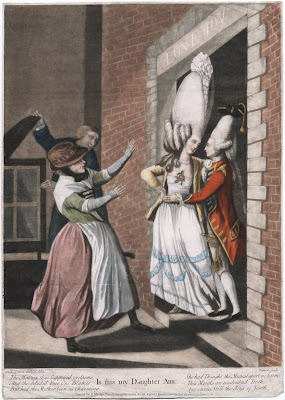Susan reporting:
When we last saw daughter Ann (in this 18th c print), she was proudly displaying her new finery and fantastically fashionable hair to her outraged mother. I wondered exactly how a country girl like Ann had come by such stylish and costly attire in London, and from her mother's expression, I suspected her mother did, too.
Soon after I posted that print and blog, I stumbled across this second print. Different artist, different publisher, but here again is our archetypal country girl Ann, still dressed to the nines (maybe even the tens) and clearly up to no good. From the shape of her breasts, it looks like she's even left off her stays, leaving her a true loose woman. This time her mother has followed her back to the city, and discovered Ann and a gentleman leaving a "house of accommodation," as Fanny Hill would have called it. Just in case there's any doubt, there's the inscription LOVE JOY over the door.
Her gallant is as fashionably/ridiculously dressed as she is, a prime macaroni with his own towering wig and tiny hat perched on the crest. Outraged Mom is again dressed in stodgy country clothes and thick soled-shoes, her hands raised in shock. She's here representing good old-fashioned morality, ready to haul her scandalous daughter back to the clean-living country where there are no men with tiny clown-hats and suggestively-jutting sword-hilts.
At least that's how it appears to us in the 21st c, with intervening Victorian morality muddling things further.
But the caption at the bottom of the print tells a different story:
Is this my Daughter Ann
The Matron thus Surpprised exclaims,
And the deluded Fair One Blames,
But had the Mother been as Charming,
She had Thought the Mutual Sport no harm.
This Moral's an undoubted Truth,
Age envies Still the Joys of Youth.
In other words, an 18th c viewer would see the scene as a hilarious mockery of withered Mom and her envy of her beautiful daughter. Ann the Fair One isn't in trouble; it's Mom who's displaying her unbecoming jealousy. Maybe we should introduce her to the Old Beau.
I have to admit I'm stymied by the male figure in the background, and whatever it is he's holding. At first I thought it might be a looking-glass for vanity, but now I'm doubting it. The man wouldn't be in the print without a purpose. Any of you more learned folk than I have a guess what that might be?
Above: Is this my daughter Ann by J.H.Grim & James Watson printmaker, published in London by S. Sledge, 1774. Copyright the Lewis Walpole Library, Yale University.

No comments:
Post a Comment